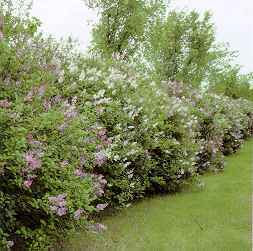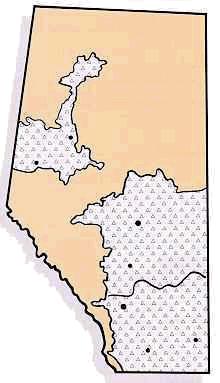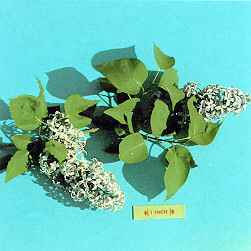| | Plant characteristics | Site preference | Hardiness | Uses | Problems | Insects | Pruning
.

Scientific Name: Syringa vulgaris L.
Plant Characteristics
The shrub originates in Southeastern Europe, was introduced to North America, and is fully hardy throughout Alberta. Large deciduous shrub, with upright branching. Common lilac is a wide - spreading shrub, up to 4 m (12 ft) in height, with a 2.5 m (8 ft) spread. Produces lots of suckering. Does not like competition.
Common lilac is a long lived, tall hedge plant. It can live 50+ years. Its growth rate is from 5 to 30 cm (2 to 12 in.) a year.
Leaves - The leaves are simple, opposite, heart shaped at the base, with pointed tips. The leaves are a dark, dull green from 7
to 10 cm (3 to 4 in.), edge smooth, surface smooth (somewhat leathery).
Flowers - Usually purple, but also creamy white, blues and pinks, are fragrant and appear in clusters which develop from the terminal bud. Floret size 5 cm (2 in.), clusters vary in size from 15 to 20 cm (6 to 8 in.). Flowers bloom from May to first week in June.
Fruit - Tan capsules produced in October.
Site Preference
Common lilac will perform well on a variety of soils. It will perform satisfactorily on dry, sandy soils, but requires a well drained soil. It is not recommended for peaty soils. Lilacs are intolerant of poor drainage and may easily succumb in areas where water stands for as short as a few days, during any part of the growing season.
Common lilac can survive drought conditions. Can tolerate some shade, but requires full sun for maximum bloom quality and production.
Moderately tolerant of alkaline conditions.
Hardiness
Winter hardy.
.


Uses
Common lilac is recommended as a single row hedge in farmstead shelterbelts, field windbreaks or roadside planting. In a multiple-row belt the lilac is recommended as a single row planting in the windward side of the belt. The habit of developing sucker growth is beneficial in creating a dense hedge. Wildlife prefer a dense hedge for protection.
Problems
The mature plant tends to develop numerous suckers. The suckering can be controlled with regular cultivation up to the hedge.
Lilac seed germination can lead to a weedy appearance.
Insects
A crown rot at ground level can cause death in some areas. Twig borers and leaf miner usually need controlling.
Pruning
Pruning should only involve the removal of dead, diseased, broken or crossed branches. Prune to remove large wide - spreading branches to keep the shelterbelt in bounds. This plant suckers freely.
.

Shelterbelts Varieties for Alberta provides information on a number of other trees and shrubs than may be suitable for shelterbelts.
Visit our website directory for the Reforestation Woodlot Listings. |
|